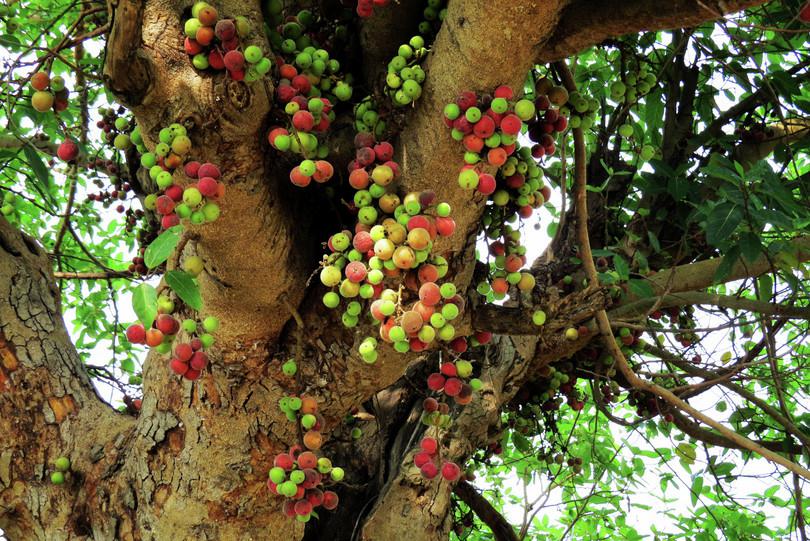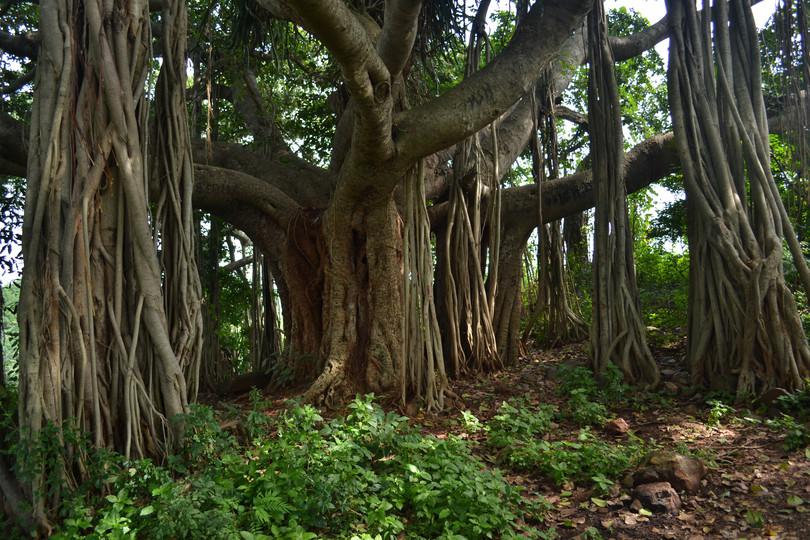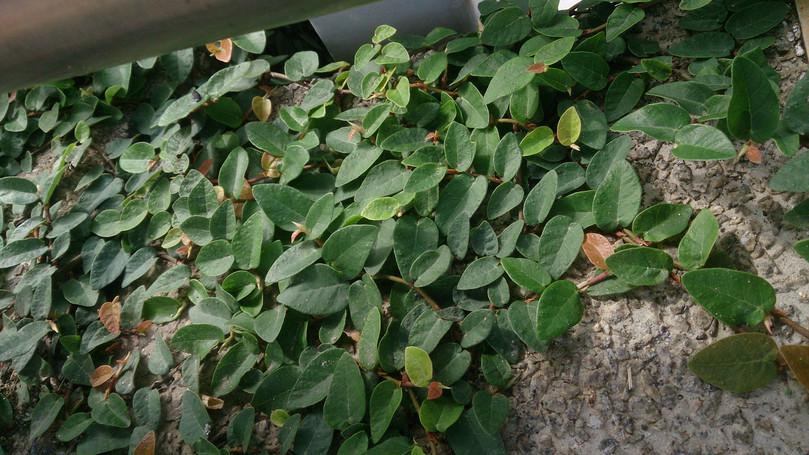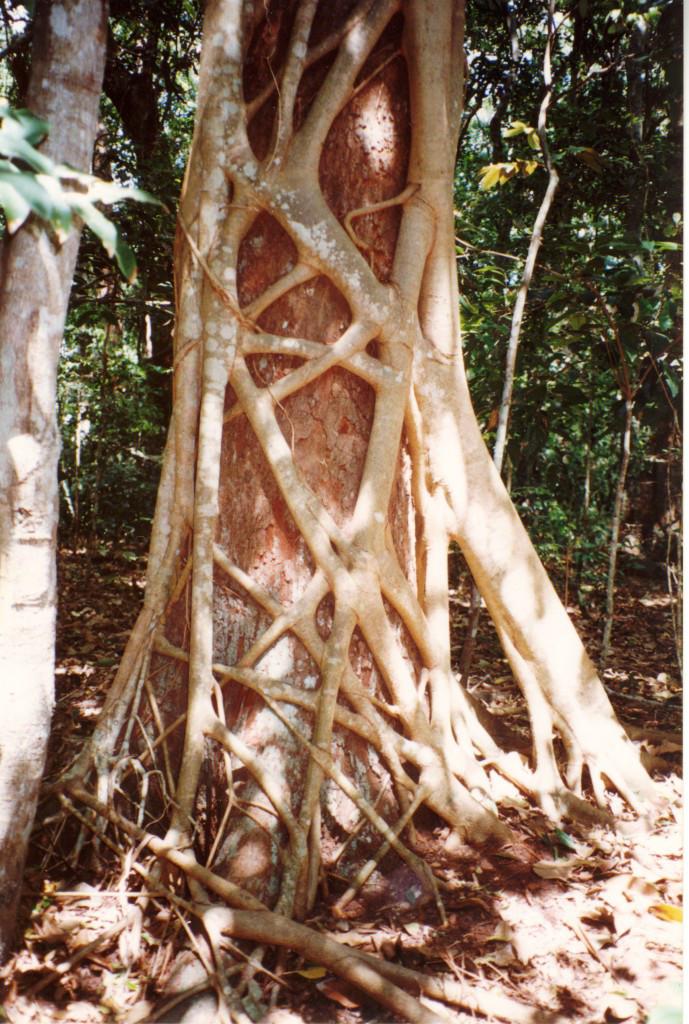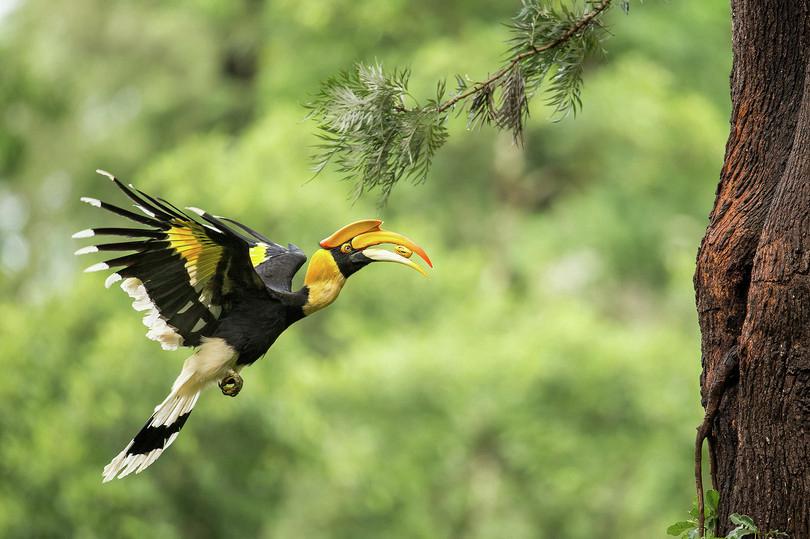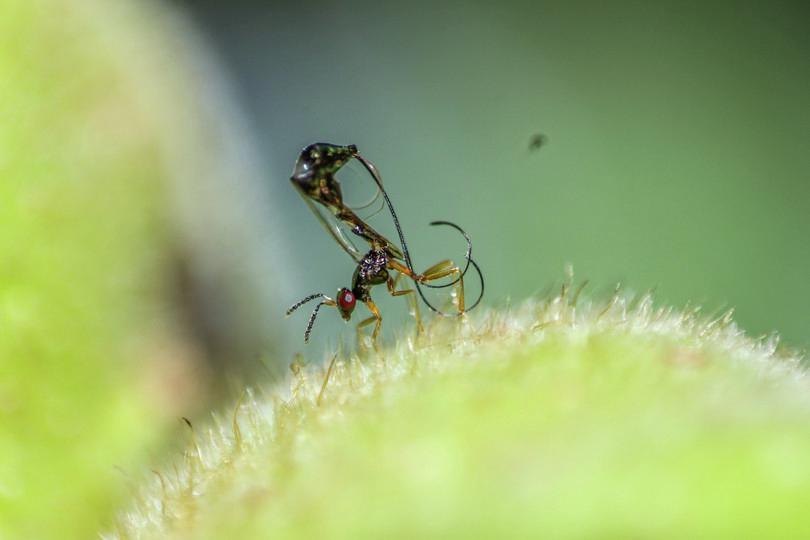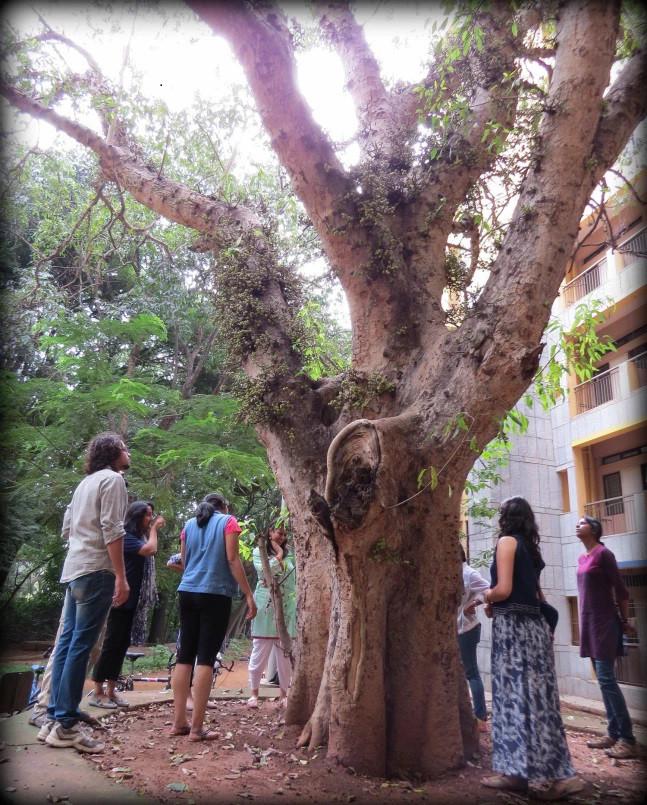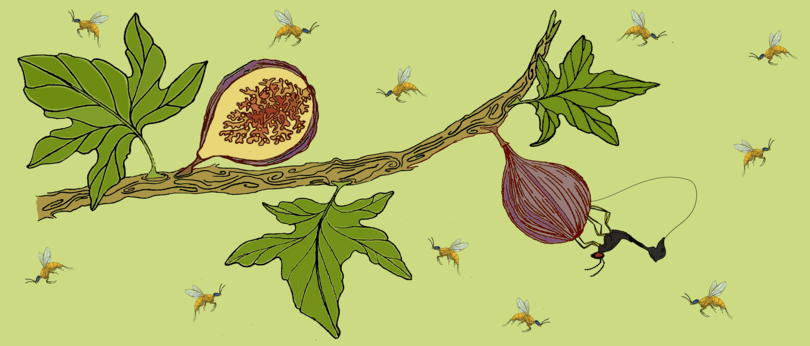
D2 Figs
D2.1 Introduction
-
Capacities taught in this chapter
Reading and interpretingWhat are the characteristics of a fig?
How does a syconium function as a closed ecosystem?Scientific processWhy are figs considered a keystone species?Scientific toolsHow do we investigate the effectiveness of seed dispersers?Bridging science, society and the environmentHow can we use the arts to communicate science?
Have you heard of or seen any fig trees in your neighbourhood or eaten figs? Some common fig trees are the anjeer tree, the peepal or ‘bodhi tree’, and the banyan tree. Figs are important plants for several reasons.
- keystone species
- A species of plant or animal that plays a crucial role in ecosystem function. Its removal could have a cascading impact on the whole ecosystem.
First, the fig is considered a keystone species, because of the disproportionately large effect it has on its environment in relation to its abundance. Fig trees within a population fruit asynchronously, produce a continuous supply of copious amounts of fruits, and are present in seasons when other fruits are scarce. Because of this, several species of bats, primates, birds and insects depend on fig trees for food.
- strangler fig
- A type of fig that germinates on another tree, wrapping itself around and eventually causing the death of the support tree. Also known as: hemi-ephiphytes.
- epiphytes
- Plants that grow on other plants and take nutrition from the surrounding environment without parasitising the host plant.
Second, the genus Ficus (Family Moraceae) is one of the most diverse and widespread of flowering plants,1 consisting of more than 750 species. Fig plants vary from woody evergreens to deciduous trees; from stranglers to vines and climbers (Figure D2.1). They occupy diverse habitats ranging from understories to canopies, savannah to rocky outcrops.
- inflorescence
- A cluster of flowers on one flower stalk.
- mutualism
- A relationship between two organisms in which both individuals benefit.
Third, fig plants have a unique inflorescence that is pollinated by a family of tiny wasps. Each fig species is host to its own species of fig wasps. Figs and the fig wasp exhibit mutualism where both parties benefit: the plant gets pollinated by wasps, and the wasp larva grows inside the fig inflorescence, feeding on the fleshy fig ovaries. Figs and their fig wasps have coevolved.
- syconium
- The fleshy inflorescence of figs that contains mutiple ovaries and develops into a fruit.
- microcosm
- Translating to ‘little world’ in Greek, a microcosm is a small community that resembles a larger one.
- parasitoids
- Organisms that develop in or on another organism, killing and using that host as a source of food.
- kleptoparasites
- Organisms that steal resources from other organisms.
Fourth, figs have an enclosed inflorescence called the syconium, which can be considered a microcosm. The syconium supports a community of pollinators, parasitoids, kleptoparasites and seed predators.
Fifth, fig trees have an enormous influence on several cultures. Gautama Buddha is believed to have found enlightenment (bodhi) under a fig tree. The fig is one of the first fruit trees mentioned in the Bible. Kikuyu tribal women in Africa smear themselves with fig tree sap to ensure pregnancy. A fig leaf is also used as an idiom in the English language, where it is used to hide an embarrassing or a shameful problem!
In this chapter we explore the fascinating world of figs to develop several capacities.
To build upon the reading and interpreting capacity, we start the chapter by understanding the unique life cycle of figs and fig wasps. By studying why figs are considered a keystone species and hornbill dependence on fig fruits we strengthen the scientific process capacity. Further, as part of the scientific tools capacity, we discuss how field sampling is used to understand if rhesus macaques are effective at dispersing fig seeds.
We then discuss science communication as the capacity of bridging science, society and the environment. Ficus trees are fast disappearing because of human activities and large development projects. We see how creating public awareness can be facilitated through art, and also through podcasts.
Finally, in the research highlight section, we look at how the ovipositor structure of the wasp mirrors its function, and various tools and techniques researchers use to determine this.
Distribution of figs in India
There are over 750 fig species worldwide, and around 500 are found in the Asian-Australian region. In India alone, around 90 species are reported.2 Figs are distributed throughout India, even in the Himalaya up to 2000 metres elevation. The greatest diversity of fig species is found in the north-eastern parts of India, the peninsular region and in the Andamans and Nicobar islands.
- endemic
- In animals and plants, endemic means a species that belongs to and is restricted to a particular region. In a disease, endemic means occurring regularly in a certain area or among certain people, animals or plants.
Some species like Ficus benghalensis (Banyan tree) are distributed pretty much throughout the country. Others, like Ficus andamanica are endemic to the Andamans. Why are different species distributed the way they are? Read the section on ‘patterns of species distribution’ in the Western Ghats chapter.
D2.2 Biology of the fig and the fig wasp
Reading and interpreting
The most unique feature of the fig plant is the mutualistic relationship between the fig plant and fig wasps. The life cycle of the wasp pollinators is intimately associated with the life cycle of its host trees.
The reproductive structure of fig plants is an inflorescence called the syconium (plural = syconia). We refer to the syconium as a ‘fruit’, but it is actually a cluster of tiny male and female flowers inside a fleshy coat (Figure D2.2a). When we refer to fig fruit in this chapter, remember that it is not a fruit like a tomato or a mango. As shown in figure D2.2b, male and female flowers do not have any petals. Male flowers bear anthers. Female flowers come in two types: one with a long style (female reproductive part), and the other with a short style (or gall flower).

Figure D2.2a A fig syconium.

Figure D2.2b Cross section of a monoecious syconium with male and female flowers in the same inflorescence. The ostiole is a hole through which pollinator wasps enter and exit.
The fig plant depends on wasps in the family Agaonidae for pollination. While the wasp pollinates flowers, it also lay eggs in the ovaries of some flowers. Short-style flowers harbour fig wasps instead of developing seeds. Since the wasps that pollinate fig flowers have short ovipositors, they are unable to access the ovaries of long-style flowers. Hence long-style flowers give rise to seeds due to fertilization by wasps. Short-style flowers in which wasps can lay eggs give rise to fig wasps.
Let us study the fig–fig wasp life cycle in a bit more detail by looking at figure D2.3.

Figure D2.3 Life cycle of fig and fig wasp.
- A female wasp carrying pollen locates a fig tree by following a unique cocktail of chemicals produced by the tree. It enters the immature syconium through a tiny hole called the ostiole.
- Once the wasp is in the syconium, the ostiole closes! The female wasp pollinates flowers and also lays its eggs on the ovaries of short-styled female flowers. The eggs hatch into wasp larvae.
- Pollinated flowers without the larvae give rise to seeds. In flowers that have larvae, the ovaries harden to form a gall in which the larvae grow. The larvae eventually pupate, giving rise to adult male and female wasps.
- As the syconium matures, male wasps emerge from the galls first. The males are wingless and have antenna and reduced eyes. Their only known function is to find females and fertilise them. After this they dig a tunnel for their mates to emerge from the syconium, and then die.
- Female wasps have wings and long antennae. They pick up pollen from mature male flowers and leave their home syconium in search of another fig tree. After finding another syconium, the female wasp enters, lays eggs and dies. The whole cycle from pollination to seed development and wasp development repeats.
The fig–fig wasp association is at least 75 million years old, with possible origins in Eurasia.3 This mutualism is special, and many fig species have their own unique wasp pollinator species. How did such a mutualistic relationship evolve? Do both the players benefit equally? Or does one benefit more than the other? We will look at some of these questions in the next section.
Exercise D2.1 Ordering events in the life cycle of fig and fig wasp
Reading and interpretingEvents in the life cycle of the fig and fig wasp are written in the wrong order. Read all the sentences and then rearrange them so that the order is correct.
- Adult male wasps emerge from their gall.
- A female wasp enters an immature syconium through its ostiole.
- Female wasps are attracted to a fig tree of the correct species.
- Flowers that have larvae form a hard gall around the larvae.
- Female wasps die.
- Male wasps mate with female wasps as they emerge from their galls.
- Pollen-laden mated female wasps leave the fig syconium in which they developed.
- Pollinated flowers that do not have larvae produce seeds.
- The eggs hatch into wasp larvae.
- Male wasps die.
- The female wasp lays eggs in the ovaries of some flowers inside the syconium.
- The larvae feed and grow inside the gall, eventually pupating.
- The ostiole closes immediately after a female wasp enters.
- The female wasp pollinates female flowers inside the syconium.
Reproductive strategies of figs
- monoecious
- Plant species that have both male and female flowers on the same plant. See also: dioecious.
Figs have two different reproductive strategies.4 Monoecious figs have both male and female flowers in the same syconium. Figure D2.4a shows a monoecious fig. This kind of fig produces seeds and is host to wasps.
- dioecious
- Plant species that have male and female flowers on different plants. See also: monoecious.
- hermaphrodite
- Organism possessing both male and female reproductive systems and the ability to produce both male and female gametes.
Dioecious figs have separate hermaphrodite and female syconia. What does this mean? Figure D2.4b shows that the hermaphrodite syconium contains both male (depicted as orange) and short-styled female flowers (depicted as beige). Hermaphrodite syconia produce many wasps and very few seeds because female wasps lay eggs in the ovaries of most of the female flowers.
- style
- The long portion of a flower’s female reproductive system that connects the stigma to the ovary.
- ovipositor
- A tube-like organ used by some animals, especially insects, for the laying of eggs.
Female syconia produce only female flowers with a long style (a flower part) as depicted in figure D2.4c. Fig wasps have a short ovipositor, so they cannot lay eggs in these flowers. Therefore, female syconia produce only seeds and no wasps.

Figure D2.4 Differences between monoecious and dioecious figs. In monoecious species (a) all syconia are essentially the same. They produce seeds and are host to wasps. In dioecious species, hermaphrodite syconia (b) give rise only to wasps, whereas female syconia (c) produce only seeds and contain no male flowers. The dashed line represents the movement of female wasps from mature syconia to immature ones.
Adapted from Cook, JM, and Rasplus, J-Y. ‘Mutualists with Attitude: Coevolving Fig Wasps and Figs’. Trends in Ecology & Evolution 18, no. 5 (2003): 241–248, doi: 10.1016/S0169-5347(03)00062-4.
Let us pause here and summarise the differences between monoecious and dioecious figs and the outcome of these in the following exercise.
Exercise D2.2 Relating reproductive strategy to structure and function of figs
Reading and interpretingWhether a syconium produces seeds or wasps or both depends on the reproductive strategy of the plant, floral morphology and floral arrangement. Complete the following table by looking at figure D2.4. Some sections are filled in as an example.
Reproductive strategy Flower Flower morphology and arrangement Outcome Monoecious Male and female flowers in the same syconium 1. Male and female flowers dispersed through the syconium
2. Both long-styled and short-styled female flowersProduce both seeds and wasps Dioecious (hermaphrodite) Dioecious (female)
Both wasps and fig plants have evolved to maximise production of their own offspring. Monoecious plants produce both seeds and wasps, whereas this is not true of dioecious plants. In dioecious plants, the reproductive interests of the two species are not aligned. This leads to conflicts that threaten the nature of their mutualistic relationship.
About half of all fig species are dioecious.4 Wasps benefit by entering the hermaphrodite syconium. They do not benefit by entering the female syconium, as they cannot lay eggs in them. But the plant must ensure that wasps nevertheless enter the female syconium in order to pollinate the female flowers. How does the plant do this?
Remember that wasps detect fig syconia by their unique volatile scent. The dioecious female fig trees exploit this aspect. The female flowers mimic the scent of hermaphrodite flowers, thereby deceiving the wasps. This is an example of pollination by deceit. How such a system may have evolved is beyond the scope of this book.
Extra reading What are hermaphrodite, monoecious and dioecious plants?
Many flowering plants produce hermaphrodite flowers. Hermaphrodite flowers contain male reproductive structures (stamens) and female reproductive structures (carpels) in the same flower.
Monoecious plants have separate male and female flowers on the same plant. A male flower has only stamens, whereas a female flower has only a carpel. Examples of monoecious plants are cucumber, coconut, maize, rice and cotton.
- outcrossing
- A process by which reproduction occurs between two individuals with slightly different genetic material.
Dioecious plants have male and female flowers on two different plants. Dioecy occurs in only about 6% of flowering plant species. One advantage of dioecy is that it enforces outcrossing. Outcrossing helps to maintain genetic diversity in the population. However, in order for pollination to be successful, there has to be a male and a female tree flowering simultaneously in a nearby area. Popular examples are papaya, date palm, spinach and figs.

Hermaphrodites, monoecious and dioecious plants.
Nefronus, Wikimedia commons, CC-BY-SA 4.0.
Summary
The intricate mutualistic relationship between the fig and the fig wasps is central to the success of fig trees. The fig plants have an inflorescence called a syconium, which is a fleshy, hollow receptacle lined by many tiny male and female flowers. After pollination by female wasps, the syconium matures, eventually producing seeds, as well as the next generation of wasps. Fig trees can be monoecious where both male and female flowers are present on the same syconium, or dioecious where separate male and female syconia are present. Male syconia produce mostly wasps and few seeds, and female syconia produce only seeds. Because of the unique reproductive strategy of figs, there is a conflict between the plants’ and the wasps’ needs.
D2.3 Studying figs as a keystone species
Scientific process
Why are figs considered a keystone species? Keystone species are organisms that have a disproportionately large effect on the environment relative to their abundance.
- frugivores
- Organisms that feed primarily on fruits.
Which animals eat figs? The answer is that a bewildering variety of creatures eat the sugary, pulpy fruit. One review enumerated 990 bird species and 284 mammal species around the world that were fig eating frugivores.5 A study in Costa Rica showed that birds feeding on a single fig tree consumed about 1 000 000 fig fruits in just five days!6
- traits
- Characteristics of organisms.
Frugivorous birds and bats eat fig fruits. They are attracted to very different kinds of fig fruits. Their preferences are based on fruit traits such as colour, size and scent. These fruit traits are suited to the morphology, physiology and behaviour of the particular frugivores that eat fig fruits.
Frugivores disperse seeds from the fruits they consume, and in turn shape the fruit diversity of figs.7 What does that mean? We will analyse a study on hornbills, which are large frugivorous birds found in South Asia, to try to understand this question.
Hornbills and figs
Some species of birds and mammals spend large amounts of time looking for figs. Some Asian hornbills (Figure D2.5a) are even known to track the availability of fig fruits in different trees present in different areas. How would you know that hornbills like fig fruits in the first place?
You would have to follow hornbills to see what fruits they eat, and record all the fruiting trees present in the area. If you only watch one or two hornbills, then you will know the preferences of those two individuals. But in order to make an overarching statement that hornbills prefer fig fruits, you need to study several hornbills in different regions and draw inferences from your observations.
- phenology
- The study of the timing of recurring life cycle events.
Kannan and James in 1999 studied frugivory in hornbills in the Western Ghats.8 They tracked the fruiting phenology of the main fruits consumed by hornbills. They also observed hornbill visitation to these trees in Indira Gandhi Wildlife Sanctuary, located in the Anaimalai hills in the Western Ghats.
How would you track fruiting phenology in a 3 km² forest? Kannan and James selected ten plots, each of which was 1 hectare. With the help of local people and taxonomists, they identified all the plants whose fruits were eaten by the great pied hornbill.
Kannan and James monitored the phenology of a total of 652 plants every month for two years and classified the fruits as lipid rich and sugar rich (Figure D2.5b). They also took notes on tree visitation of not just the great pied hornbill (also known as the great hornbill or the great Indian hornbill), but also various other hornbill species.
The scientific process has observations, and questions arising from those observations. A hypothesis is then formulated, and experiments are designed to test the hypothesis.
Not all studies may be hypothesis driven, as you can see in Kannan and James’ study. Exploratory studies can answer many important questions and enable researchers to formulate a hypothesis.
What do you infer from figure D2.5b? From the monthly variation, you can see that lipid-rich fruits were distinctly more numerous from March to May in 1992 and in April of 1993. They were markedly seasonal.
Sugar-rich fruits (such as figs) are available more or less throughout the year, but their abundance fluctuates.
Next, Kannan and James looked at how many times the great hornbills visited fig trees compared to other trees in their plots. What do you infer from figure D2.5c? Birds spend the majority of their time on fig trees. There is a dip in hornbill visits between June and August.
Hornbills time their reproductive season when there is availability of lipid-rich fruits ensuring that they have a high energy source for feeding their young. Similarly, the researchers found that fig trees are an important food source for fruit-eating birds such as small green barbet, yellow browed bulbul, and others. Thus the abundance of fig trees, asynchronicity, and year-round availability of ripe fruits allows them to support a range of other life-forms, making fig trees a keystone species.
Hornbills are large birds that consume a lot of food. Do you think this is harmful to the fig tree? The tree is not producing fruits to feed hornbills and other animals. Fruits protect the seeds, and when they are mature, help them disperse either through wind or animals.
- germination
- The process of a seed sprouting shoots and roots.
Hornbills play an important role in dispersing fig seeds. They eat the pulpy fruits, but spit out the large seeds, and defecate the small fig seeds. Such intact seeds will germinate and grow into new fig plants.9
Kannan and James kept track of the fruiting season of various trees and the bird visitation to these trees in a forested area. Indian rural areas and cities still have many fig trees, and many birds visit these trees. Think of doing a study similar to that of Kannan and James in your own neighbourhood. What may be some of the challenges for such a study?
Summary
Figs are considered a keystone species because of the disproportionately large effect they have on the environment. Kannan and James show that the great hornbills visit fig trees more than any other fruiting trees. They used a sampling technique to study ten 1-ha plots and recorded every hornbill visit to fig trees in each plot. They also measured the lipid and sugar content of figs each month. They found that hornbills feed on figs throughout the year, and hornbills and other frugivorous birds rely on figs as a source of food. The hornbill study is exploratory rather than hypothesis-driven; nevertheless, it tries to answer fundamental questions about the patterns we see in nature.
D2.4 The syconium as a closed ecosystem
Reading and interpreting
Many birds and mammals eat fig fruits, but various invertebrates depend on figs to complete part of their life cycle. The fig syconium can be considered a closed microcosm where many ecological processes can be seen.
Apart from the fig–fig wasp mutualism, there is competition among the fig wasp pollinators and non-pollinator wasps for resources and space. There are several kinds of non-pollinating species:
- Gall-inducing parasitic wasps lay eggs in fig fruits. Their larvae consume resources meant to raise seeds and pollinators.
- Parasitoids are parasitic on other fig wasps.10 These parasitoid wasps lay eggs on another fig wasp’s larvae. The parasitoid larva grows by consuming the other larva while it is still alive.
- Small worms called nematodes hitch rides on the parasitoids to go from one syconium to the other.11
- gallers
- Wasps that induce fig plants to make galls.
Indeed a syconium is a crowded and a gruesome space! Seeds, pollinating wasps, non-pollinating gallers, and parasitoid wasps all grow in this closed microcosm in a span of a few weeks. They have to time their entry and exit carefully. There are two important considerations in this system.
- The fig fruit itself has to develop. If the tree aborts the fruit, the whole community of invertebrates associated with it also perishes.
- The different species have to synchronise their development. The non-pollinating fig wasps may lay eggs in the fig earlier or later than pollinating species but their offspring have to leave the fig at the same time. This is because only the pollinator males cut a hole for their females to escape. Non-pollinating species make use of these holes to leave the syconium.
Many predators such as spiders, ants, and dragonflies position themselves near the syconium to attack the newly emerging wasps! In addition to these, many weevil, bug, and moth caterpillars are seed predators that feed on the developing seeds in the syconium. In this tiny microcosm, many species interact at different trophic levels. Several ecological interactions such as predation, parasitism, mutualism and competition can be studied in these syconial microcosms.
Exercise D2.3 Summarising the fig syconium microcosm
Reading and interpretingList all the players in the fig syconium microcosm. Make a mindmap of players in the fig–fig wasp system and all the multi-trophic interactions among them. Indicate positive and negative relationships by two-way or one-way arrows. For example, fig and fig wasp interaction is a two way arrow, as it is a mutualistic relationship.
Challenges associated with accessing the syconium
Do you remember how pollinating wasps enter the syconium? Non-pollinating fig wasps (NPFW) do not enter the syconium. Instead, they drill a hole into the syconium with their long needle-like ovipositors and lay eggs (Figure D2.6).
Fig wasp larvae do not search for the correct host. Because the larvae lack host-seeking behaviour, the female wasp must lay her eggs in precisely the correct host.
This raises more questions. How do female wasps know where to drill a hole? Do their ovipositors have special adaptations for their functions?
Research Highlight Fig wasps’ ovipositors: how structure mirrors function
Ghara, Kundanati and Borges studied the ovipositor structure of a seven–member parasitic wasp community in Ficus racemosa syconia.12 They were investigating the relationship between the structure of the ovipositors of wasps and the stage of development of the fig fruit on which they laid their eggs. The researchers developed a hypothesis and made predictions based on the natural history of the wasp community and their prior knowledge of the system.
They hypothesised that the stage of development of figs on which wasp species oviposit will influence the hardness of their ovipositors. They made two predictions:
- sclerotisation
- The process of hardening the cuticle of arthropods by cross-linking proteins.
- species that oviposit on softer, smaller/younger figs or enter the syconia early should have soft ovipositor tips with little sclerotisation.
- Wasps that oviposit on larger or developmentally mature and tougher figs should have harder ovipositor tips with more sclerotisation.
- scanning electron microscopy
- A type of microscopy that bombards a beam of electrons against the surface of a sample, producing an image of the sample.
They used scanning electron microscopy to study the structure of the ovipositors of the entire wasp community of the fig Ficus racemosa. They also measured the force required to penetrate the syconium for each species of wasps. Read about the various techniques the researchers have employed to find this out in this paper.
DownloadDownload annotated paperResearchers found that the ovipositor structure matched the functional requirement of accessing its host.
Summary
Figs are crucial for several invertebrates, where they complete a large part of their life cycle. Syconia can be thought of as a closed microcosm where one can observe several kinds of interactions including mutualism, competition, parasitism and predation. A syconium is also a physically and chemically crowded space, where several species are competing for space, mates and other resources. From the research highlight we know that fig wasp ovipositors are adapted in such a way that they can penetrate different depths of the syconium. The fig wasp ovipositor study is hypothesis driven, as compared to the earlier example of hornbill frugivory, a study which was exploratory. As we can see there are many ways to study figs.
D2.5 Are fig eaters effective seed dispersers?
Scientific tools
Figs are eaten by a diverse group of animals. If the fig seeds are destroyed in the process, then it is of no use to the plant. Do fig eaters consume the fruit while sitting on the plant and drop the seeds at the base of the plant, or do they disperse the seeds away from the parent plant? Is there any advantage to seeds being dispersed away from the parent plant?
Are animals that consume figs effective seed dispersers? We know that many birds are good dispersers, but what about primates? Sengupta, Mcconkey and Radhakrishna looked at seeds dispersed by the rhesus macaque in Buxa tiger reserve at the foothills of Himalayan region.13
The researchers were interested in knowing:
- How many plant species are dispersed by macaques?
- How are the seeds handled?
- How far from the parent tree are seeds deposited?
- What is the effect of seed handling on germination?
They studied seed dispersal in 49 species of fruiting trees, but we will only look at the fate of fig fruits in this chapter. Think about the methods and scientific tools the researchers used to address these questions.
- scan sampling
- A method of field sampling in which the behaviour of individual animals is recorded at specific intervals of time. For example, at an interval of 10–15 minutes.
How do you find out if the rhesus macaques are good dispersers of fig fruits? Behavioural observations such as scan sampling and seed germination experiments were used to answer this question. We will broadly outline the method followed by Sengupta and her colleagues.
- Locate a troop of macaques and follow them: A troop of monkeys will typically have a few adults, sub-adults and juveniles of different age groups. Make a note of their unique facial or body features so that you can identify individuals by sight (Figure D2.7). Researchers give their study subjects unique names so that they can track the same individual over days.
- Scan sample and data collection: Scan all the monkeys in the area at regular intervals and note which monkeys are eating fruits (Figure D2.7). You can determine the amount of time you want to observe each individual in a group depending on the nature of their behaviour.
- Categorise behavioural data: Record how monkeys handle the seeds. Specifically note if the seeds are ‘swallowed’, ‘spat out’, ‘dropped’, or ‘destroyed’ for all individuals.
- Collect faecal samples: Researchers collect poop (faeces) of the monkeys. Why do you think they do this? You can identify what an animal has eaten by looking at the contents of the poop. This is a common method used in ecology.
- Conduct seed germination experiments: Collect seeds that were either spat out or found in the faeces of monkeys. Collect seeds from intact fruits to provide a control group. The control is that group that is not subject to any treatment. Here, seeds that were processed by monkeys are the experimental group, and those that are from intact fruits form a control group. Germinate the seeds to compare the percentage germination and time taken for germination.

Figure D2.7 Scan sampling of monkeys in the field.
Findings of the study
Sengupta and her colleagues found that:
- The monkeys ate fruits of three fig species, and they swallowed the seeds.
- On average, the monkeys dispersed the seeds more than 70 metres from the fig trees.
- The dispersed fig seeds germinated faster, and more seeds germinated than the control seeds.
What does this mean? Passing through a monkey’s gut is beneficial to fig seed germination. Other studies have shown that passing through a vertebrate gut enhances germination for several other seeds too.14 15
Let us unpack this a bit more. What does enhancement of germination actually mean? It could mean that the seeds germinate faster or more seeds germinate or both.
- endocarp
- The layer that surrounds the seed in a fruit.
Why would a seed do better after passing through the digestive tract and intestine of an animal than staying in its own intact fruit? When a frugivore eats a fruit containing seeds, the physical and chemical environment of the digestive tract may alter the seed coat or the endocarp, thereby affecting germination. A slight abrasive effect on the seed coat will make it more permeable to water and gases. Additionally, when an animal eats a fruit, seeds will be separated from the fruit pulp, which often have compounds that inhibit germination.
Exercise D2.4 Measuring germination
Scientific processReading and interpretingQuantitative skills
- Germinate two species of monocot and two species of dicot seeds at home. Some commonly available monocot seeds are wheat and corn, and dicot seeds are beans, chickpeas and lentils. Which of the seeds consistently germinates faster? Is there a difference between dicot and monocot germination rates? How will you measure the germination rate? What factors may affect germination rate?
- Role of monkeys in seed dispersal: The graph entitled ‘Effect of passage through a monkey’s gut on seed germination’ shows the effect of seed passage through the primate gut on germination time and germination percentage according to primate diet. Primates are classified according to their diet, for example insectivore–frugivore. The first label corresponds to food type comprising of 45% or more of their diet (insects in insectivore–frugivore). The second label (if any) corresponds to food type comprising 20–45% of their diet (fruit in insectivore–frugivore). Numbers in parentheses indicate the number of independent comparisons for each effect and effects are significant if confidence intervals (the bars) do not overlap with zero.
- Look at the x-axis. What does ‘proportional change from control’ mean?
- What do the negative values on the x-axis mean?
- Why are there no units on the x-axis?
- What does a zero value represent?
- Which group had the highest germination percentage?
- Is there any relationship between germination percentage and germination time?
- What do you infer, based on this graph?
![The graph describes the relationship between seed germination after it has passed through monkeys’ guts compared to seeds from untreated intact control fruits. The x-axis gives the proportional change from the control, and the y-axis represents germination time and germination percentage.]()
Effect of passage through a monkey’s gut on seed germination.
Data from Fuzessy, LF, Cornelissen, TG, Janson, C, and Silveira, FAO, ‘How Do Primates Affect Seed Germination? A Meta-Analysis of Gut Passage Effects on Neotropical Plants’. Oikos 125, no. 8 (2016): 1069–1080, doi: 10.1111/oik.02986.
Summary
We have learned from this section that fruit eaters can facilitate seed dispersal. A study of rhesus monkeys showed that Ficus seeds passing through monkeys’ gut germinated better than intact seeds, unless the monkeys were insectivore–frugivores. Scan sampling is a behavioural tool that has been used to observe the feeding preferences of rhesus macaques. Faecal analysis is a tool that can be used to study the diet of animals. Germination studies analyse the effect of passage through the gut on germination of Ficus seeds. Studies such as these began as observations of the foraging preference of rhesus macaques. More structured studies provide answers to the effectiveness of macaques as seed dispersers.
D2.6 Science communication
Bridging science, society and the environment
Scientists are often portrayed as people in white lab coats, working in isolation on a research problem that is difficult for the general public to understand or appreciate. In reality, science is almost always collaborative, and scientists are people like you and me, with varied interests, ambitions and aspirations.
One reason that science is perceived as an esoteric endeavour is that it has much technical jargon that is difficult for the public to comprehend. Successfully communicating science and scientific outcomes is a worldwide issue, but it is particularly challenging in India. Look at the science and technology section of your newspaper and see the kind of news that gets reported. How many news items are about work done by Indian scientists?
Why do you think science communication is important? Apart from sharing the findings and excitement of science with a general audience, science is relevant in influencing public opinion and policy preferences of a country and the world. Science can explain to the public why we should wear masks in public places during the Covid-19 pandemic, and why it is important to save pollinators such as insects or why one should protect wetlands, for example.
In this section, we would like to highlight two very different ways of communicating science. The first example shows how fig biology was communicated through performing arts at a science conference. Performing arts such as theatre, music and dance can communicate complex scientific information and promote new ways of thinking about certain issues.
The second example illustrates the use of podcasts to communicate science. We take the example of a specific podcast in Kannada, ‘Janasuddi’ by Kollegala Sharma, a scientist who is also a prominent science communicator.
Communicating science through performing art
Artecology is a collective of artists and scientists who bring about awareness about nature and an understanding of environmental issues around us, and enhance sensitivity about the natural world through the medium of art. At the Student Conference on Conservation of Science held in Bangalore in 2017, Artecology performed a show called ‘How to be a fig’, a narrative/movement performance about the mysterious lives of figs (Figure D2.8).
Mutualism of figs, fig wasps, birds and mammals that depend on the fig trees, and multiple challenges on fig trees in the present times were depicted through this performance. Twenty-four people from different walks of life – from students, engineers, wildlife researchers, journalists, environmental lawyers, to teachers – were part of the performance. This performance was open to the public, and created awareness about the role of fig trees in the ecosystem. The event was widely tweeted and covered by a number of local newspapers.
Breaking barriers through podcasts
While art, illustration and dance are non-standard ways that are effective ways of communicating science, it is not possible for all of us to use these methods. But communicating through more traditional ways such as written and oral media can be as effective and is accessible for a wider section of society. Podcasts are audio episodes based on a particular theme. It is like listening to a radio show, except you can listen to a podcast whenever you want to on your phone or you can download it for listening later. Here we will tell you about a daily podcast in Kannada called ‘Janasuddi’ (which translates to ‘smart news’) that discusses the latest science stories for a lay audience.
Kollegala Sharma, a scientist in the Central Food Technological Research Institute (CFTRI), Mysore, Karnataka has been a prominent science communicator for over 40 years. In his interview (in English), he talks about how the podcast is breaking multiple barriers.
India has over 23 indigenous languages, but science communication is restricted to a few main languages, and only in a few major cities. Sharma felt the need to disseminate science in his own mother tongue, Kannada. To do this, he used Whatsapp to deliver a short daily science audio podcast. Now, Janasuddi has been broadcast by several community radio stations in Karnataka and used by many government schools to get latest science updates.
There are several very good science podcasts (like WNYC Radiolab, BBC: The Life Scientific, Microbe and NPR). Watch one or more to understand how science is conveyed through this medium.
Exercise D2.5 Make your own podcast
Bridging science, society and the environmentDivide your class or study circle into groups and make your own podcast on fig trees in your locality. Apart from the biology, include the stories around them, culture associated with them, and so on. Think of all the steps you need to keep in mind in order to make a podcast.
Once your group has completed a few episodes of the podcast, share it with students who are not taking biology to introduce them to the world of figs. Science and research communication is an important aspect of the work of any scientific community (including scientists, teachers, and students). Think of all the non-science aspects you will include along with scientific information in your podcast, for example, music and local myths. Does your podcast have a goal or objective (such as conservation of trees), or is it more information heavy?
Summary
Communicating science is as important as doing science itself. Getting the general public interested and involved in science is crucial as it influences opinion and decisions of various policies. Using art, music, dance or theatre to communicate scientific concepts is effective. They can communicate complex ideas, promote thinking from different perspectives, and can have long lasting, emotional impact. Podcasts are yet another effective way to communicate science. They can be created easily with a mobile phone, and almost anyone can make a podcast to disseminate knowledge, and get people engaged. Both communicating through art and through podcasts breaks language barriers.
D2.7 Quiz
Question D2.1 Choose the correct answer(s)
Which of these statements about the syconium is true?
- A syconium is an inflorescence seen in figs. It has an urn-like receptacle that contains many tiny flowers.
- A syconium is not a single flower but a collection of flowers or florets.
- After pollination, a syconium turns into a mature aggregate fruit (infructescence) that is edible.
- Monoecious plants have both male and female flowers in the same syconium.
Question D2.2 Choose the correct answer(s)
Fig fruit diversity is shaped by the frugivore dispersers. The figure that follows shows the fruits of six different species. What traits are characteristic of figs eaten by birds and bats?
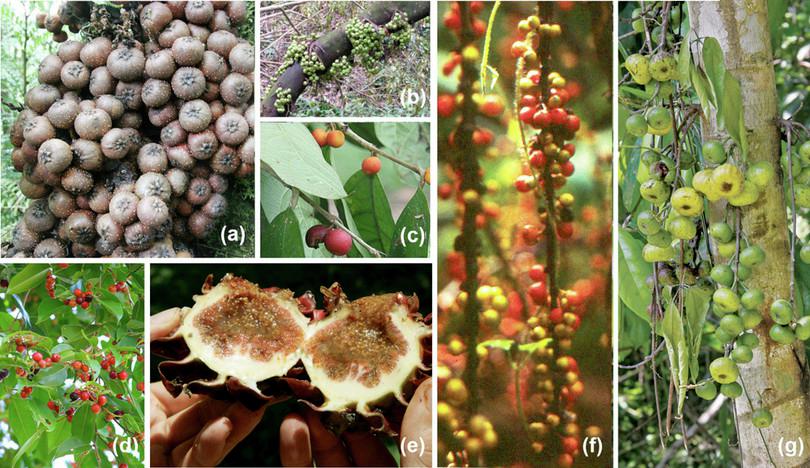
Fruits of six different fig species in Papua New Guinea. Species a, b and g are eaten by bats, and c, d and f are eaten by birds. Figure e is a cut fig showing numerous tiny seeds.
Lomáscolo, SB, Levey, DJ, Kimball, RT, Bolker, BM and Alborn, HT. ‘Dispersers Shape Fruit Diversity in Ficus (Moraceae)’. Proceedings of the National Academy of Sciences of the United States of America 107, no. 33 (17 August 2010): 14668–14672, doi: 10.1073/pnas.1008773107. PNAS exclusive license to publish for non-commercial and educational use.
- Birds have a narrow gape and colour vision. They tend to eat small, brightly-coloured figs.
- Bats forage at night, so the colour of the fruit doesn’t matter.
- Birds have a narrow gape, and they perch on a branch while eating fruits. Figs eaten by birds tend to be small, and presented between leaves along branches.
- Bats tend to eat fig fruits in flight or they will cling to the trunk and crawl towards the fruit. Figs eaten by bats tend to be on the trunk or away from foliage.
Question D2.3 Choose the correct answer(s)
Ecological communities are shaped by many interactions. Some of the interactions that can be seen in the fig tree and other organisms are mutualism, predation, herbivory, parasitism and competition. The net effect of one species on the other species can be represented as positive (+), negative (−) or neutral (0). For example, herbivory can be represented as +−. That is, one species (the herbivore) benefits, while the other (the plant) is negatively affected. It can also be represented as −+.
Which representations apply to mutualism, predation, competition and parasitism in figs and their coexisting species?
| Mutualism | Predation | Competition | Parasitism | |
|---|---|---|---|---|
| Option a | ++ | +− | −− | +− |
| Option b | ++ | +− | ++ | −− |
| Option c | +0 | −+ | −− | −+ |
| Option d | ++ | −+ | −− | −+ |
- Mutualism: both species benefit by the mutualistic interaction. Fig and pollinating fig wasps are an example of mutualism. Predation: while one species benefits, the other is harmed. Seed predator wasps benefit, while fig fruit is harmed. Competition: both species compete for the same resources. There is competition between several species of wasps for the same syconium. Parasitism: one species benefits while the other is harmed. Non-pollinating parasitic wasps are an example of this.
- Competition has a net negative effect on both species. So, it can be represented as −−
- Mutualism has a net positive effect on both the species. So, it can be represented as ++
- Order of presentation doesn’t matter. So, +− is same as −+
Question D2.4 Choose the correct answer(s)
Which of the following statements are characteristics of keystone species?
- A keystone species may not be the most abundant species in a habitat, yet it holds the habitat together.
- Keystone species can be predators, prey, plants, or mutualists.
- Keystone species may not always have a large effect in all environments. It depends on other species in the ecosystem.
- When a keystone species is removed, it sets off a chain of events that ultimately disrupts the functioning of ecosystems and results in biodiversity loss.
Question D2.5 Choose the correct answer(s)
In a study, it was found that fig seeds that passed through the gut of hornbills had enhanced germination, and had lower latency to germinate when compared to control. An appropriate control in this experiment would be:
- This would be an appropriate control. The only difference between the control and the experiment would be passage through the gut.
- Seed collected from hornbills from another area compares the effectiveness of two groups of hornbills.
- Seed collected for germination from other bird species is not appropriate, as it compares different species of birds.
- Fig fruits may be at different developmental stages. Overripe fruits may fall to the ground, and seeds may germinate, but the biochemical changes as the fruit matures will be very different from that of a younger fruit.
D2.8 References
-
Berg, CC, ‘Classification and Distribution Of Ficus’, Experientia 45, no. 7 (1989): 605–611, doi: 10.1007/BF01975677. ↩
-
Chaudhary, LB et al., ‘Synopsis of the Genus Ficus L. (Moraceae) in India’, Taiwania 57, no. 2 (2012): 193–216. ↩
-
Cruaud, A et al., ‘An Extreme Case of Plant-Insect Codiversification: Figs and Fig-Pollinating Wasps’, Systematic Biology 61, no. 6 (2012): 1029–1047, doi: 10.1093/sysbio/sys068. ↩
-
Cook, JM and Rasplus, J-Y, ‘Mutualists with Attitude: Coevolving Fig Wasps and Figs’, Trends in Ecology & Evolution 18, no. 5 (2003): 241–248, doi: 10.1016/S0169-5347(03)00062-4. ↩ ↩2
-
Shanahan, M et al., ‘Fig-Eating by Vertebrate Frugivores: A Global Review’, Biological Reviews of the Cambridge Philosophical Society 76, no. 4 (2001): 529–572, doi: 10.1017/s1464793101005760. ↩
-
Jordano, P, ‘Fig-Seed Predation and Dispersal by Birds [Ficus Cotinifolia]’, Biotropica (1983), accessed 15 February 2021. ↩
-
Lomáscolo, SB et al., ‘Dispersers Shape Fruit Diversity in Ficus (Moraceae)’, Proceedings of the National Academy of Sciences 107, no. 33 (2010): 14668–14672, doi: 10.1073/pnas.1008773107. ↩
-
Kannan, R and James, DA, ‘Fruiting Phenology and the Conservation of the Great Pied Hornbill (Buceros Bicornis) in the Western Ghats of Southern India’, Biotropica 31, no. 1 (1999): 167–177, doi: 10.2307/2663970. ↩
-
Poulsen, JR, Clark, CC, Connor, EF and Smith, TB, ‘Differential Resource Use by Primates and Hornbills: Implications for Seed Dispersal’, Ecology 83, no. 1 (2002): 228–240, https://doi.org/10.2307/2680134. ↩
-
Borges, RM, ‘How to Be a Fig Wasp Parasite on the Fig-Fig Wasp Mutualism’, Current Opinion in Insect Science 8 (2015): 34–40, doi: 10.1016/j.cois.2015.01.011. ↩
-
Krishnan, A, Muralidharan, Sm Sharma, L and Borges, RM, ‘A Hitchhiker’s Guide to a Crowded Syconium: How Do Fig Nematodes Find the Right Ride?’, Functional Ecology 24, no. 4 (2010): 741–749, doi: 10.1111/j.1365-2435.2010.01696.x. ↩
-
Ghara, M, Kundanati, L and Borges, RM, ‘Nature’s Swiss Army Knives: Ovipositor Structure Mirrors Ecology in a Multitrophic Fig Wasp Community’, PLOS ONE 6, no. 8 (2011): e23642, doi: 10.1371/journal.pone.0023642. ↩
-
Sengupta, A, McConkey, KR, and Radhakrishna, S, ‘Seed Dispersal by Rhesus Macaques Macaca Mulatta in Northern India’, American Journal of Primatology 76, no. 12 (2014): 1175–1184, doi: https://doi.org/10.1002/ajp.22302. ↩
-
Samuels, IA and Levey, DJ, ‘Effects of Gut Passage on Seed Germination: Do Experiments Answer the Questions They Ask?’, Functional Ecology 19, no. 2 (2005): 365–368, doi: https://doi.org/10.1111/j.1365-2435.2005.00973.x. ↩
-
Traveset, A, ‘Effect of Seed Passage through Vertebrate Frugivores’ Guts on Germination: A Review’, Perspectives in Plant Ecology, Evolution and Systematics 1, no. 2 (1998): 151–190, doi: 10.1078/1433-8319-00057. ↩
